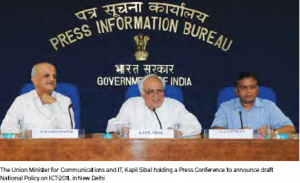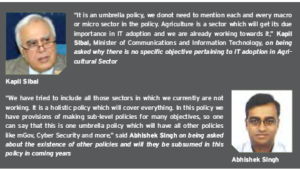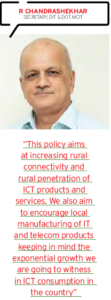
 The Indian IT sector is touted as one of the most successful and rapidly growing ones. The Indian IT industry is a US $ 88 billion industry (2010-2011) with 80 percent of its revenues coming from exports. Also, the sector is one of the main employers of the nation. It currently employs 2.5 million skilled people all over the country. It is this strong position of the sector that makes it almost indispensable to have a national level framework to define goals, objectives and vision for the better utilization of the success and scope of IT services.
The Indian IT sector is touted as one of the most successful and rapidly growing ones. The Indian IT industry is a US $ 88 billion industry (2010-2011) with 80 percent of its revenues coming from exports. Also, the sector is one of the main employers of the nation. It currently employs 2.5 million skilled people all over the country. It is this strong position of the sector that makes it almost indispensable to have a national level framework to define goals, objectives and vision for the better utilization of the success and scope of IT services.
The National ICT Policy (draft) released recently by Kapil Sibal, Minister of Communications and Information Technology aims to “Maximally leverage the power of ICT to help address monumental economic and developmental challenges the country faces.”
The much needed ICT policy outlines various objectives that the government aims to achieve by promoting the adoption and betterment of Information and Communication Technology tools all over the nation and in all the different sectors. This draft of the policy has been released after some rounds of consultation and currently is available on the internet for public’s suggestions/feedback. The underlying important point here is that we now have a base ready on which the colossal IT framework may be built.

Though just in draft stage, the National ICT policy makes one thing clear, India is not taking this IT industry for granted and we are certainly nowhere near saturation.
National IT Policy: A panacea for all ailments?

Industry Voices on National ICT Policy (Draft) “The IT draft policy is an inclusive one and an important step forward with its emphasis on specific technology areas other than IT outsourcing; an area in which India has established its credentials successfully over the last decade. Over the last few years, we have seen phenomenal progress on mission critical e-governance projects but this momentum needs to be taken to the next level and replicated by all government services to enable rural citizens to harness the benefits of technology and to ensure the last mile connectivity at a grass root level. The success of IT Draft policy requires the government to work closely through public private partnership models and include more citizens in the fold using newer technologies such as broadband,3G, mobile number portability etc.” “The IT draft policy is an inclusive one and an important step forward with its emphasis on specific technology areas other than IT outsourcing; an area in which India has established its credentials successfully over the last decade. Over the last few years, we have seen phenomenal progress on mission critical e-governance projects but this momentum needs to be taken to the next level and replicated by all government services to enable rural citizens to harness the benefits of technology and to ensure the last mile connectivity at a grass root level. The success of IT Draft policy requires the government to work closely through public private partnership models and include more citizens in the fold using newer technologies such as broadband,3G, mobile number portability etc.” |
Our aggrieved economy needs that strong push if the alleged US recession is as near as experts say. Seeing that most of the IT revenue comes from exports if the world is hit by another recession India needs to be prepared to deal with it and a large scale policy might give that support and preparedness for retaining grounds in difficult times.
The vision of the policy is “To strengthen and enhance India’s position as the Global IT hub and to use IT as an engine for rapid, inclusive and sustainable growth in the national economy.”
 The policy which was initiated earlier this year talks about some high-end goals which if achieved will put India at a permanent place on the world map as a distinguished, IT-enabled economy. Aiming to raise the revenues from IT and ITES industry to $300 billion by 2020 from $88 billion at present, the draft also maintains to mandate provision of all government services through electronic mode within a fixed time frame by enactment of the Electronic Delivery of Services (EDS) Bill.Kapil Sibal, while unveiling the policy said, “Our objective from this policy is to increase marketrevenues of IT and ITeS (IT-enabled services) industry from $88 billion at present to $300 billion by 2020 and expand exports from $59 billion at present to $200 billion by 2020 and to create a pool of 10 million additional skilled manpower.”
The policy which was initiated earlier this year talks about some high-end goals which if achieved will put India at a permanent place on the world map as a distinguished, IT-enabled economy. Aiming to raise the revenues from IT and ITES industry to $300 billion by 2020 from $88 billion at present, the draft also maintains to mandate provision of all government services through electronic mode within a fixed time frame by enactment of the Electronic Delivery of Services (EDS) Bill.Kapil Sibal, while unveiling the policy said, “Our objective from this policy is to increase marketrevenues of IT and ITeS (IT-enabled services) industry from $88 billion at present to $300 billion by 2020 and expand exports from $59 billion at present to $200 billion by 2020 and to create a pool of 10 million additional skilled manpower.”
| THE TRUST AREA OF THE POLICY INCLUDES |
- To extend NeGP, mandate provision of all government services through electronic mode within a fixed time frame by enactment of the electronic delivery of services bill
- To enhance transparency, accountability, efficiency, reliability and decentralization in government and in particular, in delivery of public services
- To increase revenues of IT and ITES Industry to $300 billion by 2020
- To make at least one individual in every household e-literate
- To formulate fiscal and other policies to attract investment in IT Industry in Tier II and Tier III cities;
- To promote innovation and R&D in cutting edge technologies and development of applications and solutions in areas like localization, location based services, mobile value added services, cloud computing, social media and utility models;
- To provide fiscal benefits to SMEs and start-ups in the key industrial sectors for adoption of IT in value creation;
- To leverage internet, web and mobile technologies for developing new products, technologies and businesses;
- To integrate internet-based and mobile-based delivery of services onto a common platform to enable seamless, ubiquitous, secure and personalized delivery of government and non-government services throughout the country;
- To integrate Aadhaar, financial and location-based services into this integrated platform to foster an ecosystem for innovation in services.
- To create a pool of 10 million additional skilled manpower in ICT;
- To leverage ICT for key social sector initiatives like education, health, rural development and financial services to promote equity and quality;
- To make India global hub for development of language technologies to encourage and facilitate development of content accessible in all Indian languages and thereby help bridge the digital divide;
- To enable access of content and ICT applications by differently abled people to foster inclusive development;
- To facilitate adoption of ICTs in key economic and strategic sectors to improve their competitiveness and productivity;
- To strengthen regulatory and security framework for ensuring a secure cyberspace ecosystem
Cloud Burst?
Yet again, the Cloud is in the forefront when it comes to IT adoption future plans. So much has been said about the Cloud yet there is much more still not unveiled. So agreed Naveen Prakash, Prinicipal Analyst, Gartner, “Cloud Computing in India is still in a nascent stage. There is a lot of talk but much more is still to be achieved in terms of adoption and application. India can surely do a lot more in this particular technology.”
The ICT policy clearly laids out Cloud Computing as one of the main objectives for the coming decade- “to gain significant global market share in cloud based technologies,” it states.
On talking with Ashis Sanyal, eGov Consultant on the same, he said, “Worldwide acceptance of cloud computing technologies has slowed down a little bit recently. In India, campaigning for cloud computing by OEMs,System Integrators and Service Providers is in a good pace. However, considering the common psyche of the government departments, I feel that good use of cloud computing technologies in Public Sector, sharing of infrastructure, software etc will take some more time.”
Where all is well on focusing on global markets and increasing market share, a little more attention should be put on application of cloud within our own country. “It is time now to look at cloud computing to fast forward IT adoption and deploy more and more applications which will ultimately reduce the Total Cost of Ownership (TCO) of computing as a whole. It time to focus on the domestic market,” said Tanmoy Chakrabarty, Vice President & Head Global Government lndustry Group, Tata Consultancy Services.
One of the objectives also puts stress on building R&D on technologies such as cloud computing, GIS, Mobile technologies, Language Technologies and more.
Mobility All the Way
The policy draft seems to realise the crucial importance of mobility as a technology and as a medium to access services. One of the objectives of the draft are to gain significant marketrevenues share in mobile-based value-added services.
In the Government sector, the authorities are waking up to the capacity and advantages of a better connected atmosphere. Recently, Rajya Sabha has announced that it is planning to go paperless by giving all the members tablets-a huge step towards mobile connectivity. In governance sector, more and more recognition is being given to agile mobility solutions. It is costeffective, quick and demands lesser manual work.
Internationally, telecom is keenly being recognised for not only connectivity but a major facilitator of socio-economic development. In India alone the telecom market is the most booming with 100 million active mobile internet users projected over the next 5 years, India’s rapidly evolving enterprise mobility (EMM) market is likely to be $1 billion by mid-2015. Taking these factors into account mobility and VAS are being touted as the next big thing and so is the objective to promote them in the coming years.
As we all know,As we all know, in our country, mobile phone is the only medium by which we can reach the 1.2 billion population and thus promotion of the same is of the utmost importance. The draft policy also has several mention of mobile technology as well as promotion and development of Value-added services.
It is pertinent here to mention that few months back an exclusive mGovernance Policy draft was issued by the Department of Technology for public consultation. The goals, however much more specific and defined, are somewhere overlapping with the objectives of the ICT Policy. The same was clarified with Abhishek Singh, Director-eGovernance, DIT, Ministry of Communications and Information technology. He said, “The national ICT policy (Draft) is being prepared as an umbrella policy. We have made provisions for sub-level policies under this one policy for various sectors. If we talk about the mGov Policy it will definitely be finalized simultaneously and promoted for the mGovernance agenda.”
Mobile governance highly depends on various factors and nationwide connectivity is the most important for it. Unfortunately there is no specific mention of how we envision enableing this connectivity in the policy. Also, the importance of mobile as a medium to deliver services has to be formally recognized which will happen when the Electronic Delivery of Services (EDS) Bill will be passed. Agreeing on this note, Ashis Sanyal said, “If EDS bill comes through in next 4-5 months time and with the planned 10 years timeline for implementation, then m-Gov policy will definitely get a big push forward. This is because the Draft Bill talks about “multi-channel delivery” of government services and mobile channel is one very important channel of delivery for that purpose. Therefore it is very important for the bill to go through to get the m-Gov policy to get quickly firmed up.”
The Vision
The fact that our authorities have realized the importance of IT-enabled economy and taken some proactive steps towards it is a good sign displaying that we are serious to become an ITempowered nation and soon. The policy has very ambitious objectives and it underlines the importance os IT in all sectors
and for the economy as a whole.
The policy aims at pushing IT adoption in SMEs and households also. One of the interesting objectives laid down in the policy is “To make at individual in least one every household e-literate.”
This objective portrays a long-term vision of the government wherein they aim to make every household e-enabled. It can be envisioned in a futuristic scenario where there is proper penetration of the broadband and connectivity and after that having one person e-literate will mean more people using e-services in a very effective manner thus more people utilizing the infrastructure that will be laid down now. “If this particular objective is materialized Then as a result there will be less number of commuters in the public transport, less number of two and four wheelers on the road, consequently less environmental pollution, saving of significant opportunity cost, time and effort for every individual, less crowding in the service delivery counters, less frustration for the government officials in meeting aggrieved citizens and so on. The list can be long and all would be towards better quality of life,” quipped Ashis Sanyal.
 The policy also highlights the importance of National e-Governance Plan (NeGP) and aims at extending it in the coming years. NeGP has been able to put in place a lot of basic infrastructure for effective delivery of public services via electronic medium. “To extend the National e-Governance Plan (NeGP) and mandate provision of all Government Services through Electronic mode within a fixed time frame by enactment of the Electronic Delivery of Services (EDS) Bill” states the policy as one of the objectives.
The policy also highlights the importance of National e-Governance Plan (NeGP) and aims at extending it in the coming years. NeGP has been able to put in place a lot of basic infrastructure for effective delivery of public services via electronic medium. “To extend the National e-Governance Plan (NeGP) and mandate provision of all Government Services through Electronic mode within a fixed time frame by enactment of the Electronic Delivery of Services (EDS) Bill” states the policy as one of the objectives.
Hope on the horizon
The market, experts as well civil society have welcomed this move of introducing three major policies this year namely, National Telecom Policy, National Electronics Policy and National ICT Policy. As R Chandrashekhar, Secreatary, Department of Information Technology & Department of Telecom, Ministry of Communications & Information Technology said, “All three are indispensably linked to one another and despite having exclusive policies cannot be viewed in isolation anymore. These are three interconnected sectors and thus government is viewing them together.” All these sectors have proven to be building blocks of our economy and are also together responsible for a lot of domestic development as well as global market share.
 Department of Information Technology and Department of Telecommunications have together initiated these policies which are all currently in draft stage. “In India, policies are only a beginning and real challenge is implementation,” said Chandrashekar. Agreed, in our country we might take years for a draft policy to finally get into the shape of a Bill and then get passed in the Parliament and finally comes in the form of an Act, it might seem like a small step to initiate drafts of policies. However, the act that the policies have been initiated and we have moved towards achieving the ultimate goal of becoming a fully IT-empowered economy is itself worth cherishing.
Department of Information Technology and Department of Telecommunications have together initiated these policies which are all currently in draft stage. “In India, policies are only a beginning and real challenge is implementation,” said Chandrashekar. Agreed, in our country we might take years for a draft policy to finally get into the shape of a Bill and then get passed in the Parliament and finally comes in the form of an Act, it might seem like a small step to initiate drafts of policies. However, the act that the policies have been initiated and we have moved towards achieving the ultimate goal of becoming a fully IT-empowered economy is itself worth cherishing.
A digitized India is well on its way and we will all witness history being created in front of us when India undergoes this digital transformation or which might be termed as IT revolution 2.0.
Be a part of Elets Collaborative Initiatives. Join Us for Upcoming Events and explore business opportunities. Like us on Facebook , connect with us on LinkedIn and follow us on Twitter, Instagram.











